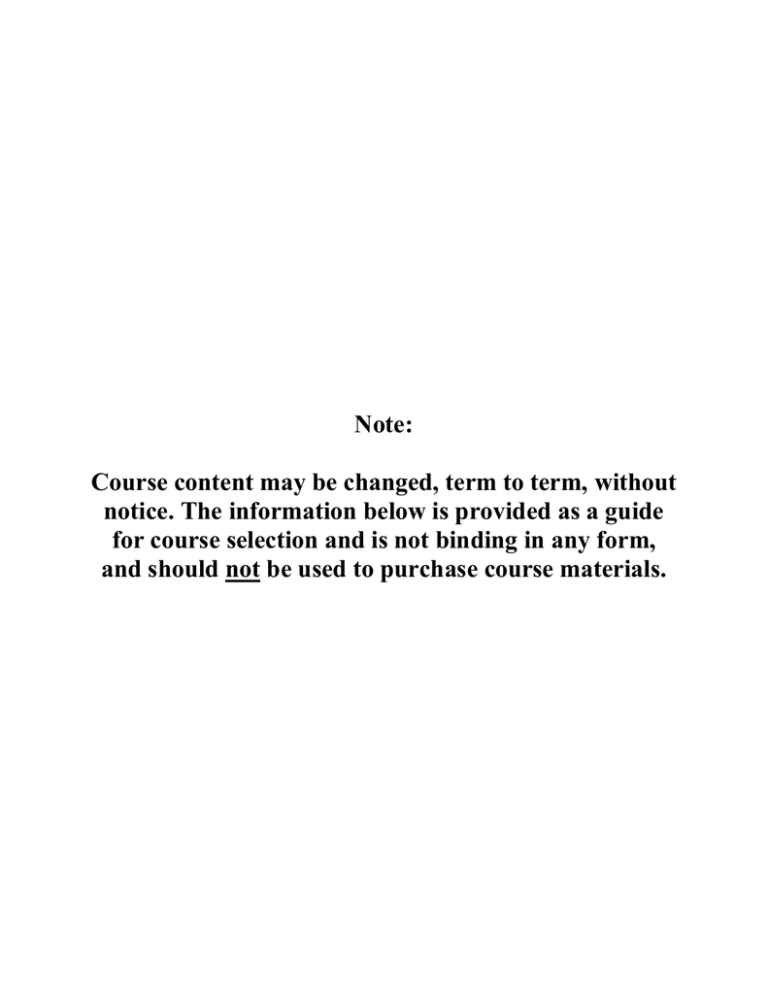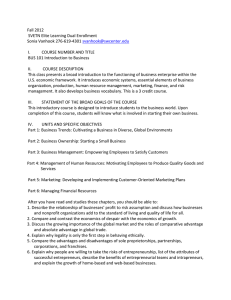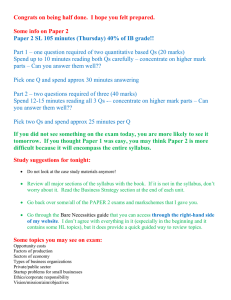Note: Course content may be changed, term to term, without
advertisement

Note: Course content may be changed, term to term, without notice. The information below is provided as a guide for course selection and is not binding in any form, and should not be used to purchase course materials. ARTS 352 Course Syllabus COURSE SYLLABUS ARTS 352 GRAPHIC DESIGN I COURSE DESCRIPTION While introducing theory, practice, and technology, course assignments will develop an understanding and put into context the principles of visual communication. This course will develop strong formal and technical skills, as well as introduce production technology. This course focuses on conceptual thinking and problem solving in relation to design development. Students will create identity systems for a specified company or organization. Students explore the difference between branding different types of corporate entities and will produce work geared toward inclusion in the final portfolio. (Formerly ARTS 341) RATIONALE Graphic Design is communicating visually in an interesting and vital way. The successful graphic designer presents information in a manner that will communicate meaning through various expanding mediums including print, web, and digital media. While principles of good design remain constant, technology and methodology develops at a constant and rapid pace. The student of design must balance his or her development of the creative and theoretical with his or her skill of utilizing the tools and technology of the trade. Learning and developing is a continuous process and quest. There will be an emphasis on developing a Christian worldview as applied to this discipline. I. PREREQUISITE For information regarding prerequisites for this course, please refer to the Academic Course Catalog. II. REQUIRED RESOURCE PURCHASE Click on the following link to view the required resource(s) for the term in which you are registered: http://bookstore.mbsdirect.net/liberty.htm III. IV. ADDITIONAL MATERIALS FOR LEARNING A. Computer with basic audio/video output equipment B. Internet access (broadband recommended) C. Microsoft Office MEASURABLE LEARNING OUTCOMES Upon successful completion of this course, the student will be able to: Page 1 of 4 ARTS 352 Course Syllabus V. A. Conceive, express, and present ideas that visually solve identified graphic design problems. B. Recognize the target audience for a given design problem and create engaging solutions to reach that audience. C. Create unique graphic and written content where appropriate. D. Distill complex ideas and give them appropriate visual form. E. Demonstrate evolving graphic design skills and aesthetics. F. Make and utilize effective typographic choices and demonstrate attention to detail and craft. COURSE REQUIREMENTS AND ASSIGNMENTS A. Textbook readings and lecture presentations B. Course Requirements Checklist After reading the Course Syllabus and Student Expectations, the student will complete the related checklist found in Module/Week 1. C. Discussion Board Forums (7) Discussion boards are collaborative learning experiences. Therefore, the student must create a thread in response to the provided prompt for each forum. Each thread must be at least 300 words, demonstrate course-related knowledge, and be supported by biblical principles. In addition to the thread, the student must reply to the threads of at least 3 other classmates. Each reply must be at least 150 words and supported by biblical principles. D. Project Part 1: Creating a Design Brief The student must formulate a Creative Brief that will outline the entire design process for the Brand Development design project. The Brand Development project will consist of one substantial body of work that is broken up into 4 phases throughout the course. The student must learn to craft a detailed creative brief. E. Project Part 2: Brand Development The student must develop a comprehensive branding system for an assigned fiction or non-fiction client throughout the semester with minimal instruction from the instructor. Projects within the system must include a minimum of 5 touch points such as logo and stationery, promotional items, printed materials, packaging, screen based materials, and a brand standards manual. F. Project Part 3: Brand Development Continued The student must practice the process of design from research and concept development, to final execution and presentation of ideas. The student must be prepared to present his or her work in an online format for the class and participate in critiques of his or her peers. The student must remember to reach Page 2 of 4 ARTS 352 Course Syllabus out to the instructor if he or she gets stuck with a topic or design challenge. The instructor is there to help the student with this process. G. Project Part 4: Brand Development Final The student must finalize the development of the comprehensive branding system. The student must be prepared to present his or her work in an online format for the class and participate in critiques of his or her peers. H. Process Book Project The student must create a process book that outlines and illustrates his or her creative process as well as the steps necessary to create his or her branding system. Additionally, the student must professionally present his or her final work during the final exam period and produce an online portfolio that highlights his or her best projects throughout the semester. VI. COURSE GRADING AND POLICIES A. Points Course Requirements Checklist Discussion Board Forums (7 at 20 pts ea) Project Part 1: Creating a Design Brief Project Part 2: Brand Development Project Part 3: Brand Development Continued Project Part 4: Brand Development Final Process Book Project Total B. 10 140 100 200 200 200 160 1010 Scale A = 900–1010 B = 800–899 C = 700–799 D = 600–699 F = 0–599 C. Late Assignment Policy If the student is unable to complete an assignment on time, then he or she must contact the instructor immediately by email. Assignments that are submitted after the due date without prior approval from the instructor will receive the following deductions: 1. Late assignments submitted within one week of the due date will receive a 10% deduction. 2. Assignments submitted more than one week late will receive a 20% deduction. 3. Assignments submitted two weeks late or after the final date of the course will not be accepted. 4. Late Discussion Board threads or replies will not be accepted. Special circumstances (e.g. death in the family, personal health issues) will be reviewed by the instructor on a case-by-case basis. Page 3 of 4 ARTS 352 Course Syllabus D. Disability Assistance Students with a documented disability may contact Liberty University Online’s Office of Disability Academic Support (ODAS) at LUOODAS@liberty.edu to make arrangements for academic accommodations. Further information can be found at www.liberty.edu/disabilitysupport. Page 4 of 4 COUR ### Course Schedule COURSE SCHEDULE ARTS 352 Textbook: Wheeler, Designing Brand Identity (2006). MODULE/ WEEK READING & STUDY 1 Wheeler: pp. 2–4, 102–103 1 presentation 2 ASSIGNMENTS POINTS Course Requirements Checklist Class Introductions DB Forum 1 10 0 20 Wheeler: pp. 16–34 1 presentation DB Forum 2 Project Part 1: Creating a Design Brief 20 100 3 Wheeler: pp. 36–80 1 presentation DB Forum 3 20 4 Wheeler: pp. 82–94 1 presentation DB Forum 4 Project Part 2: Brand Development 20 200 5 Wheeler: pp. 96–101, 104 1 presentation DB Forum 5 20 6 Wheeler: pp. 106–122 1 presentation DB Forum 6 Project Part 3: Brand Development Continued 20 200 7 Wheeler: pp. 124–150 1 presentation DB Forum 7 20 8 Wheeler: pp. 152–174, 208–209, 218–219, 232-–33 1 presentation Project Part 4: Brand Development Final Process Book Project 200 160 TOTAL 1010 DB = Discussion Board NOTE: Each course module/week (except Module/Week 1) begins on Tuesday morning at 12:00 a.m. (ET) and ends on Monday night at 11:59 p.m. (ET). The final module/week ends at 11:59 p.m. (ET) on Friday.




